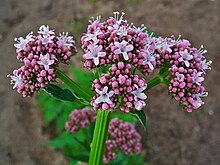Valeriana
| Valeriana | |
|---|---|

| |
| Garden valerian, Valeriana officinalis
| |
| Scientific classification | |
| Kingdom: | Plantae |
| Clade: | Tracheophytes |
| Clade: | Angiosperms |
| Clade: | Eudicots |
| Clade: | Asterids |
| Order: | Dipsacales |
| Family: | Caprifoliaceae |
| Subfamily: | Valerianoideae |
| Genus: | Valeriana L. |
| Synonyms[1] | |
|
List
| |
Valeriana is a
garden valerian, Valeriana officinalis. Species are native to all continents except Antarctica, with centers of diversity in Eurasia and South America (especially in the Andes
).
Taxonomy
The genus was named by
Botany
Species from this genus are herbaceous and have woody roots. They grow vines with fine hairs and trifoliolate,
cymes.[5]
Fossil record
Fossil seeds of Valeriana sp, among them †Valeriana pliocenica, have been recovered from Late Miocene deposits of southern Ukraine, and from Pliocene deposits of south-eastern Belarus and Bashkortostan in central Russia. The fossil seeds are most similar to the extant European Valeriana simplicifolia (a subspecies of Valeriana dioica).[6]
Species
As of December 2020[update], Plants of the World Online accepts over 420 species and hybrids, including:[1]
- Valeriana alypifolia
- Valeriana aretioides
- Valeriana asterothrix
- Valeriana bertiscea
- Valeriana buxifolia
- Valeriana californica
- Valeriana celtica (Alpine valerian or valerian spikenard)
- Valeriana cernua
- Valeriana coleophylla
- Valeriana dioica (marsh valerian)
- Valeriana edulis
- Valeriana fauriei (Korean valerian[7])
- Valeriana montana
- Valeriana occidentalis
- Valeriana officinalis(garden valerian)
- Valeriana pauciflora
- Valeriana pyrenaica (Pyrenean valerian)
- Valeriana secunda
- Valeriana sitchensis (Sitka valerian)
- Valeriana uliginosa
Gallery
-
Valeriana officinalis
-
V. montana
References
- ^ a b c "Valeriana L." Plants of the World Online. Royal Botanic Gardens, Kew. Archived from the original on 25 June 2020. Retrieved 28 December 2020.
- .
- ^ Harper, Douglas. "valerian". Online Etymology Dictionary.
- ^ Lewis, Charlton T.; Short, Charles (1879). "vălĕo". A Latin Dictionary. Perseus Digital Library.
- ^ Acevedo-Rodríguez, Pedro (April 2020). "Caprifoliaceae" (PDF). Guide to the Genera of Lianas and Climbing Plants of the Neotropics. National Museum of Natural History, Smithsonian Institution.
- ^ The Pliocene flora of Kholmech, south-eastern Belarus and its correlation with other Pliocene floras of Europe by Felix Yu. VELICHKEVICH and Ewa ZASTAWNIAK - Acta Palaeobot. 43(2): 137–259, 2003
- ISBN 978-89-97450-98-5. Archived from the original (PDF) on 25 May 2017. Retrieved 24 December 2016 – via Korea Forest Service.
External links
 Media related to Valeriana at Wikimedia Commons
Media related to Valeriana at Wikimedia Commons- USDA records of the distribution of the genus in the United States


